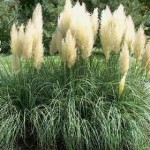 Typically, we wait until the very end of winter to cut back ornamental grasses in Silver Spring. But for some reason, this year they’ve been looking more tattered than usual, despite the absence of heavy snowstorms that generally decimate them. We have, however, been blessed with one or two days each week when the temperatures have climbed to 50 degrees or more, and this allows us to tackle some seasonal gardening chores, such as dealing with these ornamental grasses.
Typically, we wait until the very end of winter to cut back ornamental grasses in Silver Spring. But for some reason, this year they’ve been looking more tattered than usual, despite the absence of heavy snowstorms that generally decimate them. We have, however, been blessed with one or two days each week when the temperatures have climbed to 50 degrees or more, and this allows us to tackle some seasonal gardening chores, such as dealing with these ornamental grasses.
See the before, during, and after photos of a grouping of ornamental grasses that we decided to cut back in early February this year. The result made the nice stand of ornamental evergreen trees behind the grasses (3 or 4 varieties) really stand out for the rest of winter. As shown, a power hedger makes cutting back such mature grass stands easy, though it is quite time-consuming to package all those cutting for disposal. (You can also tie the grass bunch together before cutting, with rope or duct tape, to keep the cuttings together). Doing it now, leisurely, allows more time during the very busy early spring for the multitude of other chores.
There are various other landscape tasks that can be done at this time. Many deciduous trees and shrubs are best pruned now while they are dormant and their structure is easily visible. Jump start garden bed clean up now, again to free up some time in the spring for many other things. Hopefully, you’ve left many plants, with drying seed heads, in addition to the ornamental grasses, standing through the winter to provide interest and feeding opportunity for birds. These too are likely beginning to topple and can be cut back.
You can also begin to remove old leaves and other plant debris sitting on the ground around plants. It is, in fact, important to protect plants with compost or mulch, and often, fallen leaves contribute to this. Also fallen plant matter decomposes and feeds the soil. However, this debris, unfortunately, can harbor insects and diseases that overwinter in it and the soil beneath. If left untouched, this debris becomes a prime suspect to attack your ornamental plants in the spring. Ditto for clusters of fallen tree leaves that piled up after the fall leaf cleaning. Breezes may have blown leaves up against shrubs and trees, and the large mats of leaves can also harbor pests and prevent needed moisture from reaching the base of plants.
You can start removing this material now, but do not leave bare ground around plants – they do need some protection from the cold. Once temperatures moderate, you can finish the cleanup proceedings by applying compost or mulch around your plantings. You may not need to pick up old debris under all plants. Focus on those that are most susceptible to insects and diseases – roses for example, and other plants that have shown evidence of pest problems. Keep in mind that pests will also overwinter in weeds that are around – such as winter annuals — and this is yet another reason to remove them promptly.
Winter is the “off-season” for gardening. So, take advantage of those warmer days to tackle tasks such as these. Your spring gardening chores will be easier.
FEB
2013



